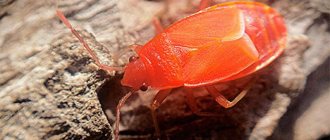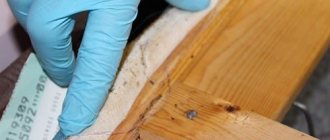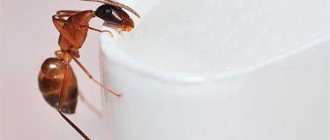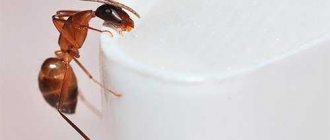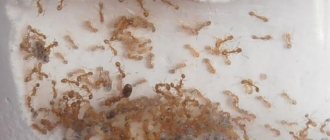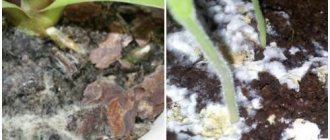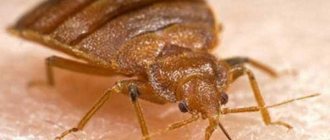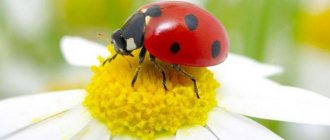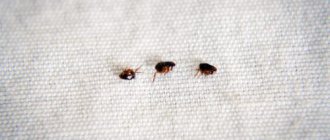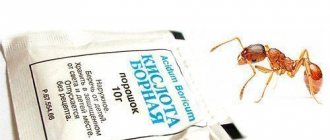Many of us in the spring near our house noticed a cluster of soldier bugs - beautiful bright bugs of the red bug family. These seemingly harmless insects cause irreparable harm to agricultural plants. Sometimes the soldier bug (wingless red bug, Cossack bug) accidentally ends up in a person’s home, which is safe, but not very pleasant. Home owners should quickly find methods to get rid of insects and prevent them from appearing in the future. And to understand how to get rid of annoying bugs, you need to know what they look like, where they live, what they eat and how they reproduce.
External differences of the soldier bug
The body of the soldier bug is round, slightly flattened. The insect has a bright color: the body is black, the pronotum and elytra have a red pattern. Bedbugs have no wings. The eyes are red, the mustache and paws are black. The length of the soldiers is 8–11 mm. The oral apparatus is equipped with a piercing-sucking proboscis, which is in a horizontal position.lenslensesadventurenaturetimedicdoc.macro
When eating food, the proboscis tenses and becomes like a needle. With its help, the insect pierces plants and feeds on cell sap.
Red bugs often gather in groups in one place - adults and larvae, which is a distinctive feature of the species. The name “soldiers” comes from the property of being arranged into unique divisions and the colors of the chitinous cover.
Who is often confused with?
The red bug is often confused with two insects:
- Firefighter beetle, soft beetle (Cantharidae). In fact, insects have nothing in common with each other, except for confusion in names. The fire beetle belongs to the order Coleoptera. It has a long body 1–1.5 cm - twice as long as that of the soldier bug. The elytra and tarsi are black, with filamentous whiskers. The mouthparts are gnawing. Insects have wings with which they move through the air. The beetle's abdomen is orange or red.a.koptyrevana_tasha.shgita089
- Blackhead (Corizus hyoscyami).
In appearance, the insects are very similar to each other. The differences are in the position of the head: triangular, slightly tilted, and the shape of the pattern on the back. The eyes are darker than those of the soldier bug - closer to brown. Insects live mainly on umbrella plants: onions, dill. The larvae feed on henbane and tobacco leaves. The henbane bug is very similar to the soldier bug
In England, the soft beetle is called the soldier beetle due to the similarity of its color to the uniform of the royal guards.
Life cycle
The lifespan of the wingless bug is 12–14 months. When living in warm regions, two generations of insects appear, in cold regions - one.
The soldier larva does not have such a bright cover
By the end of August, the soldiers' metabolism slows down, i.e. they are preparing for hibernation - suspended animation. After going to sleep, insects survive due to the nutrients accumulated over the summer period and slow metabolism.
The awakening of bedbugs occurs in March - April, as soon as the sun begins to warm the earth and the first vegetation appears. Some young individuals and females cannot withstand the spring cold and die. In May, adult female bedbugs lay eggs. The process of insect formation takes place in several stages: egg – larva – bug. Newly formed females continue breeding in mid-late June.
What does it eat?
Soldier bugs feed on seeds, juice of plants and fruits, and the remains of other insects. They get food closer to the ground; they will climb a tall tree only as a last resort. In the absence of sufficient food, bedbugs feed on weeds and even their own relatives.
Red bugs have a powerful proboscis that can pierce fairly hard shoots and plant seeds. Insects are not capable of harming humans. The proboscis cannot pierce the skin of an adult or child.
Small larvae feed only on the sap of young shoots. The mouthparts are not fully developed, and insects are not able to pierce other plants.
Soldier bugs, like all representatives of the species, have odorous glands. In adult insects they are located on the chest, in larvae - on the abdomen closer to the dorsal part.
Where is it distributed?
The soldier bug is widespread throughout Eurasia, northern Africa and the United States. Countries with a temperate climate are favorable for insect reproduction.
Bedbug habitat:
- under the bark of trees;
- on stumps;
- in piles of dry grass and leaves;
- at the foundations of houses, baths, gazebos and other outbuildings;
- in the fence and its foundation.
kath_gruendisorder_vortexentomologist_arina
During hibernation, insects are found under heaps of garbage, in humus, in trees - under the bark or in hollows.
How does it reproduce
Insects reproduce rapidly during the spring and summer. In warm regions, bedbugs produce two generations from May to July. The colony quickly increases in size and, when living on the site, rapidly “attacks” cultivated plants.
When mating, the male and female are attached to each other by the rear parts of their bodies. Insects can remain in this position from one to two hours to several days. After the seed cells enter the female’s body, the bugs separate.cora_jones_wild1752koreneva_irina23medvebooks
The female lays eggs in habitats, on plant leaves or in such a place that it is easier for the larvae to get food. The clutch can consist of 16–30 white eggs, shaped like grains of rice. On the top of the eggs, peculiar caps are formed, through which the larvae appear - after seven to ten days.lilabums
Young individuals can remain motionless for a long time, feeding on the sap of the plants on which they are located. In appearance, they differ from adult insects not only in their small size. The larvae are completely red, without black inclusions.
Black on red
Essentially, soldier beetles are a type of land bug. Their longitudinal backs are painted in a rich red color, on which there is a symmetrical black pattern. The largest individuals are a little more than a centimeter. It looks like such a beautiful bug, but what will be the result of it - benefit or harm?
There will be no particular harm to a person from soldier beetles in the house - they do not bite, do not torment at night and do not spread infections. And the children will enjoy the beautiful insects. House plants are a completely different matter. Until recently, by the way, it was believed that these bugs feed only on other insects and fruits that have fallen from branches (apples, for example).
Also, young beetles feed on their juice using a special small proboscis. And a plant that has lost its juice begins to die almost immediately. But if all living things are eaten, only then do the soldiers take on dead insects and rotting plants. Be that as it may, we have absolutely no need for such inhabitants in the apartment. And if you have green friends living on your windowsill, you need to fight soldier beetles.
Reasons for appearance
The main reasons for the appearance of soldier bugs on the site include:
- rotten stumps in the garden;
- dried plants;
- piles of dry garbage and leaves;
- a large number of weeds, especially quinoa and wormwood;
- legumes;
- woodpiles;
- alfalfa in your or neighbors’ garden;
- growing carrots, cabbage, beets, and currants on the plot.
Insects especially love alfalfa. To get rid of the larvae, you need to pull out the weed along with the roots and burn it.
All gardeners have the soldier bug
The insects often nest in legumes and alfalfa to survive the winter cold.
In some cases, bedbugs may appear in an apartment, more often in a private house. If you have indoor flowers, seedlings or other vegetation, insects will multiply very quickly. There is a tendency that when one soldier appears, other relatives come running after him. In the absence of food, they die or go to other places.
Now in the heat, now in the cold
The most accessible method of controlling insects is boiling water. Toy soldiers are no exception. Pour boiling water over the places where they accumulate, especially those that are darkened. If there are few soldiers, this will help. What to do in winter?
Oddly enough, it is even easier to get rid of soldier beetles in the house in winter, because in the wild they live exclusively in warm tropical places, so even small changes in temperature are very unfavorable for them. Ventilate the room by opening the windows wide for several hours. No one from the colony will survive, you can be sure.
How to fight insects
When pests appear, it is necessary to immediately take measures to destroy them. Insects reproduce quickly and can cause considerable damage to garden crops. There are different methods to get rid of the soldier bug.
Natural enemies
The natural enemies of soldier bugs are birds, mantises and bats. A pungent odor can scare off certain birds, such as tits. Sparrows are good at destroying insects, but they can also harm crop plants. When red bugs get caught in a web, many spiders discard them due to the pungent odor.
Its poisonous color and smell make it invulnerable
The coloring of the red bug is a camouflage with which it protects itself from natural enemies. For birds and spiders, red is a signal that the insect is poisonous and should not be eaten. Soldier bugs are well protected from destruction precisely due to this property.
Chemicals
When using chemicals, it is necessary to take into account that when insects are killed, harm will be caused to the soil and the plants themselves. Soldier bugs have the ability to adapt to pesticides, so each subsequent generation does not die from the previously used poison.
Methods for getting rid of soldier bugs:
- independent processing of the site. In this case, you must carefully read the instructions to comply with the indicated dosages, processing times and precautions. Karbofos, Malathion and Aktara are used as poisons, which cause paralysis of insects. The powder drug “Bankol” effectively destroys soldiers. For use, the product is diluted in water. The pesticide is considered to be of low toxicity to plants, soil and people; mir_zelenyi89succulentia.ru
- professional disinfestation. Experts will select a product taking into account the characteristics of the soil. This type of treatment is especially recommended for large areas. The advantage of turning to disinfectants is the comprehensive destruction of various types of pests.
In a house or apartment, soldier bugs can be destroyed using regular Dichlorvos.
Light traps
Light traps are used to catch insects. With their help, you can reduce the population of soldier bugs, but they cannot be completely eradicated. Most often, males and unfertilized females fall into them.
There are many types of traps, and you can easily buy the most suitable one in stores. The operating principle depends on the type of light emitted:
- ordinary light is visible radiation. Pests crawl into the light and stick to the adhesive surface or are sucked in by the built-in fan;
- ultraviolet light is invisible to humans. An insect attracted by radiation is killed by the electrical grid.
ultraviolet lightlight trap
Various powders and agents are added to some types of traps that impede the movement of bedbugs or paralyze them, as a result of which the insect dies.
Traditional methods
To destroy soldier bugs, you can use traditional methods that will not cause any harm to cultivated plants and soil.
The following means are used to control insects:
- Onion peel. Pour the husks halfway into a large container and fill with cold water. Leave for 5-6 days. Strain the finished infusion and treat the plants on the site with it.
- Soap solution. Grate 300 g of laundry soap onto ten liters of water on a coarse grater. Treat the plants with the prepared solution. It is not recommended to increase the amount of soap.
- Mustard powder. To process 1 sq. m of plot is needed for 10–12 liters. add 100 g of powder to water. Leave the solution for 1.5–2 hours. Treatment can be carried out once every 10–14 days.
- Wood ash. Dilute 200 g of product into a bucket of water. Using wood ash you can not only kill insects. The natural product is beneficial for the soil - it enriches it with potassium.
- Hunting belts. Special windings are attached to tree trunks, onto which poisonous or sticky substances are applied that restrict the movements of insects. They can be formed in the form of funnels and bowls equipped with containers.
- Manual assembly.
Soldier bugs move quickly, so collecting them will not be easy. Use shovels to shovel large accumulations into prepared containers for disposal. Squash single insects directly on plants, like Colorado potato beetles. Traditional methods of control will help repel pests
When soldier bugs enter a living space, they are destroyed using kerosene or vinegar. To do this, treat baseboards, furniture legs, and plinths with the product. To catch single representatives, you can lay out sticky strips - Velcro - on the floor.
Chemical and folk remedies against pests
To get rid of persistent insects using chemicals, you need to strictly follow the instructions. The modern market offers the following effective means:
- Bankol is a non-toxic product for humans. Dissolve 5-7 ml of the substance in 10 liters of water and treat plants with bugs, larvae and eggs. The drug causes paralysis of the nervous system in insects.
- Malathion (Karbofos) is a poisonous agent intended for the disinfection of premises and garden pests.
- Actellik is an organophosphate compound used to poison pests in gardens, barns and other premises.
- Tsifoks destroys bedbugs, ants, cockroaches, fleas and other pests.
All chemicals must be dissolved in cold water to preserve their toxic properties. Cold water will help suppress the pungent odor of the substance when treating bedbug habitats.
The disadvantage of chemical treatment is that it harms not only insects, but also crops and soil. In addition, bedbugs can gradually get used to the poison.
It is better, of course, to get rid of colonies of soldiers using folk remedies. Let's describe the most popular of them:
- Laundry soap solution. Dissolve 300 g of crushed soap in a bucket of water. This solution will also help remove other insect pests. You can also treat a pre-trimmed garden plot. Sprinkle the soil with soap shavings, add water, and cover the area to be treated with a thick cloth. When the soap shavings dissolve, the soldier bugs will try to hide in the fabric; it should be rolled up and burned.
- Onion decoction. For 10 liters of water you will need 200 g of husk, leave the broth for 5 days. Treat plants with the resulting product no more than once every 5 days.
- Sarepta mustard solution. Dissolve 100 g of dry mustard in a bucket of water and spray the garden plot with the solution.
- Ash solution. Dilute 150 g of ash in a bucket to make a thick solution, and thoroughly spray the crops.
The soldier bug will not turn into a serious pest if you take timely measures to expel it from the site and do not wait for a massive bedbug invasion.
Why is the soldier bug harmful?
Soldier bugs are far from harmless animals, as is commonly believed. They feed not only on seeds and remains of dead insects. Pests suck the juice from young shoots, leaves, and fruits, causing great damage to garden crops.
Damage caused by firebugs:
- they like to suck the juice from grape fruits, as a result, the yield of the bushes is significantly reduced. Damaged berries become unsuitable for food;
- The insect's proboscis is quite powerful, so it can pierce hard seeds and thick shoots. The plant from which bugs suck out beneficial juices gradually stops blooming, bearing fruit and dies;
- affects tree trunks and branches;
- damages cabbage and beet leaves, leaving small punctures on them;
- destroy seeds sown in the soil;
- are dangerous pests for emerging seedlings. The bugs suck out the nutritious juice, causing the sprouts to dry out.
Fire bugs cause harm when there are a lot of them
A large colony of insects can cause significant damage to summer cottages, farms and vineyards.
Habitats
Beetles, popularly called soldier beetles, are most often encountered on the street or in the garden. They nest in old rotten wooden logs, tree trunks or plank fences. Sometimes such surfaces are literally strewn with colonies of soldiers.
But in these places, insects just rest, but to obtain nutrients they go hunting, depositing young growth in the garden and causing irreparable damage to the crop in the garden. Gardeners often find soldiers in cabbage , carrot or beet tops, on the leaves of garden trees or currant bushes. In any case, if the owner of the site discovers colonies of soldier beetles nearby, he should immediately think about how to drive them away.
Despite its outwardly harmless appearance, the bug causes serious damage to garden crops. The insect lays eggs directly in plants (on leaves or stems), while simultaneously sucking out all the juice from them. They are especially dangerous for elite grape varieties. Due to the fact that they feed on the juice of garden crops, they are classified as serious pests. The gardener must understand that it is not so much the adult soldier bugs that cause harm, but rather their eggs and larvae. And for this reason, their appearance in the garden area should be prevented in a timely manner. Often these garden pests cause damage to young shoots of beets, carrots, dill and other garden vegetation. Plants that have not yet become strong and have not gained vitality simply die from the influence of soldiers.
What does the soldier bug eat?
In order to effectively combat garden pests, it is necessary to understand what these insects eat and where do they live?
The red beetle with black spots, popularly known as the soldier bug, is completely unpretentious in food. Few people know what soldier beetles eat, but this information is very important, especially for gardeners who can suffer significant losses from black-and-red pests.
So, in order to exist fully, the red-black beetle only needs plant sap. He obtains it by piercing leaves or stems with a sharp proboscis. After such an impact, the cultivated vegetation stops bearing fruit and gradually dies off. If soldier beetles damage vegetable, fruit or berry fruits, then they cease to be suitable for consumption. If there is no fresh sap nearby, then black-and-red bugs can even eat carrion. Bed bugs gather in colonies on dead insects, and sometimes they can even be seen on the corpses of vertebrate animals. Oviposition is done by this insect directly on the leaves, cuttings and stems of plants. This prevents the risk of food shortages for the young. Young red larvae will always find something to eat, thanks to this placement of oviposition. Gathering in large colonies, they cause irreparable damage to many garden and vegetable crops:
Preventive methods
To prevent the appearance of soldier bugs, you can take the following measures:
- Planting on a cohosh plot. Translated from Latin, the plant is called black cohosh. The smell of flowers repels insects, and they try to immigrate away from it. It is convenient to plant the plant around the perimeter of the site. You can also use other plants: wormwood, mustard.
- Plant grape bushes and other cultivated plants away from alfalfa and legumes, which are especially loved by soldier bugs.
- Destruction of weeds on the site. Weed your garden in a timely manner. As the grass grows, the number of pests increases, as does the number of eggs laid. If possible, burn the grass as there may be larvae on the leaves.
- If there is a lawn on the site, the height of the grass should be as minimal as the type of cover allows.
- Do not leave heaps of garbage or fallen leaves on the site - the favorite habitats of red bugs.
- If there are rotten and old stumps, it is necessary to uproot them and burn them.
Soldier bugs reproduce quickly and can cause significant damage to cultivated plants. At the same time, they have a thin chitinous cover and a poorly developed nervous system, so they are easy to destroy. Carrying out preventive measures will protect the area from insect infestation.
Source
Frighten with smell
It is no secret that substances with a specific odor repel many insects, and toy soldiers are no exception. Pour vinegar over the places where they accumulate, also treat the corners of the room, secret places, the legs of the bed and chairs - the beetles will simply run away, frightened by this aroma.
If you yourself don’t want to breathe vinegar fumes, pick a couple of sprigs of the most common wormwood, which grows everywhere. Moreover, you can take dry branches. Tie a small broom (or several), hang it on the wall, or place a few branches in corners and hard-to-reach places. After that, you can forget about insects.
We suggest you read: How and how to quickly remove lice and nits: effective methods of control
A decoction of onion peels, a solution of mustard and an aqueous solution of ash will also help. In addition to these methods, you can also use kerosene, turpentine or camphor oil - in short, anything that has a specific fragrant aroma.
